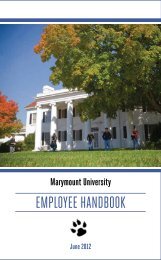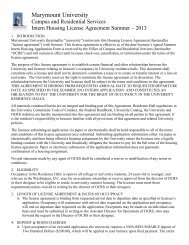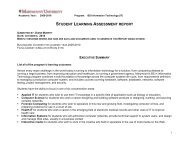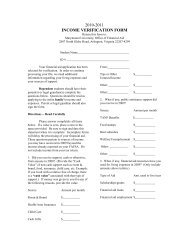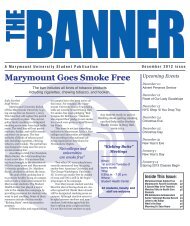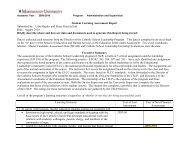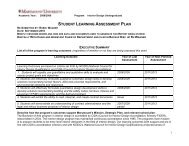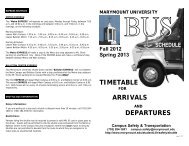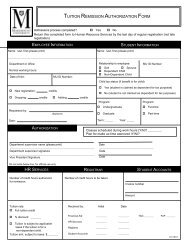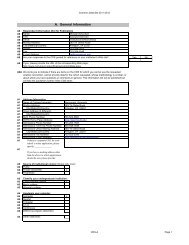Student Handbook - Marymount University
Student Handbook - Marymount University
Student Handbook - Marymount University
You also want an ePaper? Increase the reach of your titles
YUMPU automatically turns print PDFs into web optimized ePapers that Google loves.
spill, or if an odor of gas or a noxious substance is<br />
detected in your area, leave the area immediately and<br />
call Campus Safety at (703) 284-1600.<br />
• If possible, secure the area to prevent others<br />
from entering.<br />
• If the hazard is thought to place all building<br />
occupants at risk (e.g. the odor of natural gas), pull<br />
the fire alarm to evacuate the building.<br />
• In campus science laboratories, follow the<br />
posted instructions.<br />
• Do not re-enter the building/area until it is<br />
determined safe by emergency responders.<br />
Robbery/Assault<br />
• Cooperate, giving the person exactly what he/she is<br />
asking for, nothing more.<br />
• Try to notice distinguishing traits: clothing, race,<br />
height, weight, age, eye color, facial hair, or other<br />
identifying features such as scars, moles, etc.<br />
• Pay attention to the type of weapon used,<br />
if applicable.<br />
• Listen carefully to the person’s voice for<br />
distinguishing characteristics.<br />
• Record what direction the person goes after the<br />
confrontation. If a vehicle is used, record the license<br />
plate number, as well as the make and model.<br />
• Call Campus Safety at (703) 284-1600 (ext. 1600 on<br />
campus) immediately following the incident. Campus<br />
Safety personnel will come to your assistance and<br />
notify the police.<br />
Situations Requiring Evacuation,<br />
Lockdown, or Shelter-In-Place<br />
Evacuation<br />
Whenever a building alarm sounds, you must evacuate<br />
to a distance of at least 100 feet from the building.<br />
Await instructions from Campus Safety officers or other<br />
emergency personnel.<br />
Lockdown<br />
In the event of an emergency involving an imminent<br />
threat of harm, it may become necessary to “lockdown”<br />
one or more buildings to protect occupants and minimize<br />
overall exposure to danger. A lockdown is a temporary<br />
sheltering technique that may last anywhere from a few<br />
minutes to several hours. When alerted that the campus<br />
21<br />
or specific buildings are in lockdown, occupants of any<br />
building within the subject area are to remain inside,<br />
away from windows, and lock room doors and windows.<br />
Do not shelter in a hallway; go to an office, classroom,<br />
or residence hall room that can be locked. Turn off room<br />
lights, stay away from windows, and remain quiet. No<br />
one should enter or exit the lockdown area until the<br />
“all clear” has been sounded. If you are outdoors when<br />
the lockdown is announced, take shelter in the nearest<br />
campus building.<br />
If specific buildings or areas of the campus are known to<br />
be unsafe at a given time, instructions to evacuate/avoid<br />
those buildings or areas will be given by Campus Safety<br />
personnel or a public safety official.<br />
Shelter in Place<br />
In the event of a chemical or biological attack, the order<br />
to “shelter-in-place” may be given.<br />
To shelter in place<br />
• Move to an interior room or hallway with no windows.<br />
• On your way to the sheltered space, close windows<br />
and doors to the best of your ability.<br />
• Yellow emergency kits are located in easily accessible<br />
locations in each campus building. They contain<br />
basic first aid supplies, emergency equipment, and<br />
instructions on sheltering in place.<br />
• Designated personnel will be responsible for turning<br />
off air-handling systems to reduce the flow of air into<br />
the buildings from outside.<br />
• Specific instructions will be provided by Campus<br />
Safety officers and, in the residence halls, by Campus<br />
and Residential Services staff. Remain indoors until<br />
you are advised that it is safe to leave. Shelter-inplace<br />
would likely be needed for no more than a<br />
few hours.<br />
Personal Preparedness<br />
While <strong>Marymount</strong> is prepared to meet the basic needs of<br />
the campus community during an emergency situation,<br />
it is still a good idea to be personally prepared. You may<br />
wish to assemble a personal emergency kit. Items that<br />
the American Red Cross recommends include<br />
• a small first aid kit and extra prescription medications<br />
• emergency contact and medical information<br />
• sanitation and hygiene supplies



